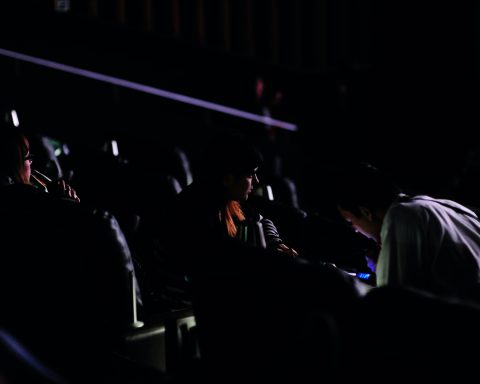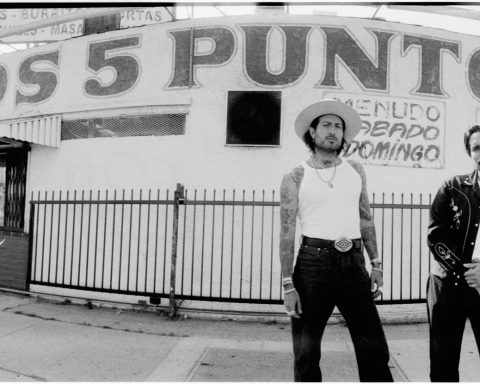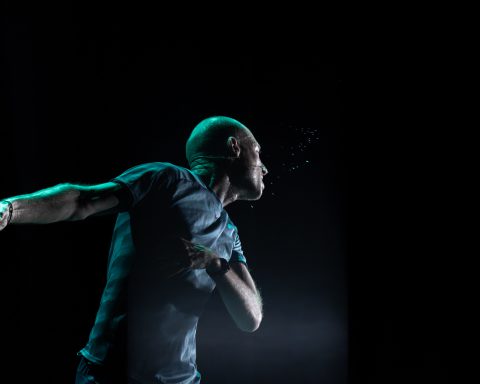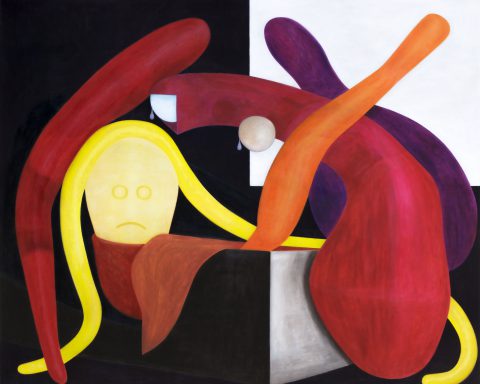If you haven’t been to the Spinnerei yet, this weekend is the time to go. They have open studios 3 times a year, and spring is arguably the nicest time. Rundgang is the time you get to see what’s going on behind closed doors. Up to 15,000 people visit over the two day period. To be honest, it can be a bit of an overload. Here are my top gallery show picks:
Stephanie Stein: Untitled (substitute) @ ASPN
Stephanie Stein works with pure geometrical shapes and figures in the sense and tradition of Minimal Art. Her works take up room and volume. They alternate between sculptural intervention and arrangements. Clearness and space, perspective and light become the protagonists of the exhibition room. An expansive installation consiting of two works definies the show. Stein isolates and concentrates single elements out of a system of signs that might not have a semantic content. As forms, her works mainly refer to themselves and – by doing so – they imply understanding and misunderstanding as well as translation as an option of understanding in a nonverbal sense.
Hans Aichinger @ maerzgalerie
I interviewed Hans for DW a couple of years ago. Like his work, he was down to earth, open and honest. His work has a very long process that begins with photography. He decides on what he wants to paint, usually using people he knows. Then he has a photographer shoot it, being careful to get every detail exactly how he wants it. Then he starts working from the photo. Because it’s such a painstaking progress, he makes very few pieces a year. The way he works also allows for a transcendence of space and time, leaving him the freedom to create real and unreal realms.
Capitalist Melancholia @ HALLE 14
One of the reasons I really like the exhibitions at HALLE 14 is that it’s non-profit. That means they aren’t there to make you buy. They are there to make you think.
The degree of individual and collective, spiritual, ecological, and economic exhaustion and burnout we are experiencing today has led to a unique sort of 21st century melancholy. This is the result of an inability to differentiate between economics and politics. Eliminating the public sector, deregulating markets, and significant cuts in social security have been seen as economic panaceas for decades. And when markets are deregulated, life is deregulated as well. An economy of desires running on empty serves as the motor leading to an exhaustion of life and squandering of resources. The exploitation of the earth, warming of the atmosphere, overpopulation, and the far-reaching consequences of the “New World Disorder” such as hunger, poverty, waves of refugees, civil wars, and terrorism are manifestly unstoppable. While the present continues to hyperventilate, shaping the future and the course of history has become something inconceivable.
For Sigmund Freud, the “deep and painful malaise” of melancholy is characterized by a “withdrawal of interest in the external world” and “loss of the capacity to love.” During the Romantic period, the pensive wistfulness and exuberant idealism of the melancholic were still seen as a divine madness common in people doing creative work. The artworks on display at the exhibition and the symposium/performance “A Government of Times” invite us to pause for a moment, reorient ourselves, and reflect on new perspectives, raising questions about political fantasy and a different form of acceleration – an experimental, navigational process where we can discover a universe of possibilities.
Miriam Vlaming @ Galerie Dukan
Perhaps it’s the fact that Miriam Vlaming had originally started studying Educational Science, Psychology and Sociology before switching to painting at the HGB that makes her work so emotionally deep. While she attributes her figurative nature to the New Leipzig School (she studied under Arno Rink, spending two years as one of his master students after graduating), she chooses to explore the limits of abstraction. She also rejects today’s painting techniques by using tempera, giving her work the illusion of being woven into the canvas. It also allows her to create visible layers; a suggestion of other worlds.
After 20 years of development, this exhibition symbolises a new phase in the evolution of Vlaming’s work. Her first works see-sawed between childish dreams and nightmares. Then she exposed “Friends – Family” in intimate situations, absence – presence as per her own experiences and trips (such as in Africa). Next came “the immovable pictures”, a sort of disenchantment of the family house, asleep, wilted, with seemingly calm country landscapes that inadvertently feel mournful.
The current work exhibited in EDEN finds Miriam Vlaming beginning an observation period of the dark, the empty, and of death. This period is characterised by a genuine and formal liberty, like a catharsis leading to a fully accepted maturity which, little by little, guided her steps towards light. These new works explore forgotten worlds between dream and reality, with blazing colours, symbols of vitality and rebirth. The represented human being is a survivor, personifying finiteness. We dive in a rebirth period in Vlaming’s work, like a genesis or an acceptance of life, which is just as scientific as it is mystical. This terrestrial paradise vibrates of serenity while opening up the path to new and more optimistic fields, festive and conquering.
Check art leipzig. for up to the minute info on the latest in visual art openings









